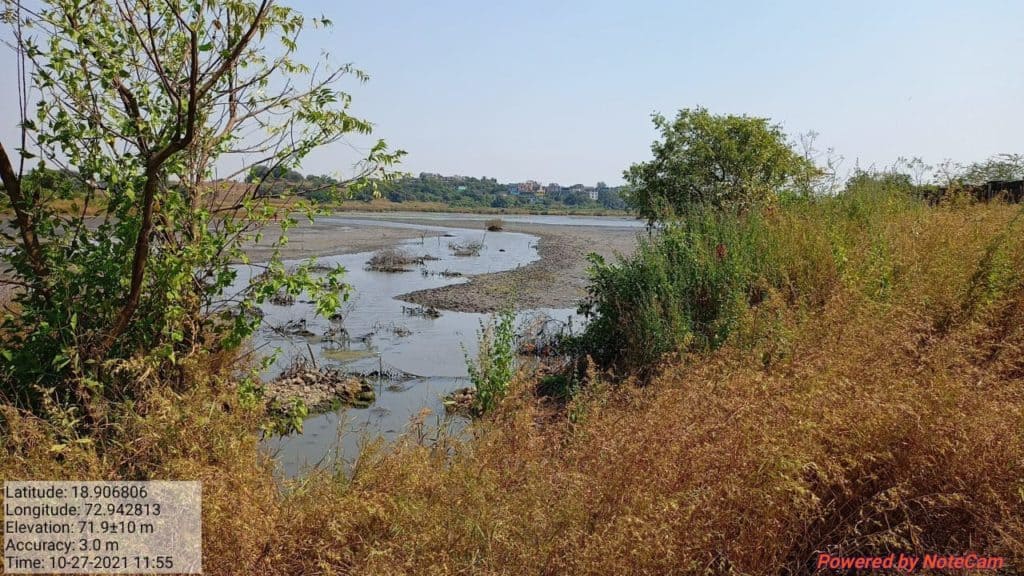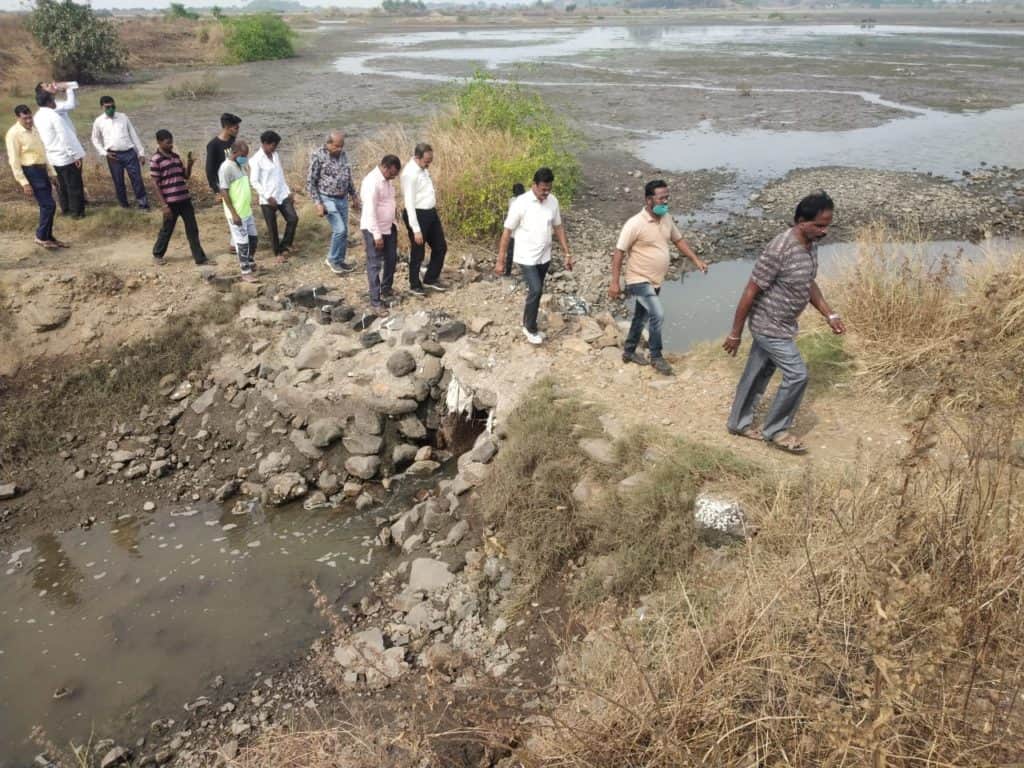Located south of Mumbai is Panje, one of four neighbouring villages, Panje, Funde, Dongri and Bokadvira spanning 289 hectares of wetland. Every winter, 1,50,000 migratory birds of over 50 species return to roost here. Of them, the Indian skimmer was recently upgraded from vulnerable to endangered. To some, however, this land is prime location to acquire for constructions, due to its close proximity to all forms of transport, including the upcoming Navi Mumbai airport.
In 2019, Reliance Industries (RIL) sub-leased 4000 acres, including Panje, from the Navi Mumbai Special Economic Zone (NMSEZ) to develop the area into a “Global Economic Hub”.
There has been a slow effort to prepare Panje for “development”. An 8ft-high wall, 70 sluice gates and 5 culverts control the flow of tidal water reaching the wetlands. Mangroves have been hacked and buried. Security guards prohibit local fishermen, birdwatchers and researchers. Parallelly, environmental activists have consistently reported, filed complaints and won against the rising destruction of the area. Orders to put a stop to it have come from the Mangrove Cell, appointed by the Bombay High Court, National Green Tribunal (NGT) and more. They have all gone unheeded, until now. On November 9th, the Collector Raigad filed an action report complying with the orders.
This success is owed to many activists, including Nandkumar Pawar, who has consistently filed complaints, RTIs and petitions to call attention to the destruction. He is the founder of Shree Ekvira Aai Pratishthan (SEAP), an environment and fishers’ rights group.
Below is an edited interview with him.
Why is Panje threatened?
City and Industrial Development Corporation (CIDCO) has been the planning authority in Uran taluka since 1970, where it’s responsible for acquiring land from various stakeholders, like fishermen and local farmers, under the Land Acquisition Act 1894. After acquisition, the first thing they did was block all natural inlets of tidal water by constructing a concrete wall and sluice gates, which not only prevents water from entering but also drains any accumulated stormwater.
The whole point is to dry out the mangroves and landfill the water bodies, so the land can be used for development.
Particularly in the Dronagiri node, where 99% of the area is 3m under the high tide line, at least 13-14ft of debris landfill would be essential for any project. CIDCO’s official papers acknowledge this, designating it as a holding pond for stormwater, so it can act as a flood control mechanism.
And yet, shockingly, in 2004 they leased 1250 ha of ecologically sensitive area to NMSEZ. CIDCO holds a 26% stake in it, the rest is owned by Reliance, Jai Corp and SKIL Infrastructure.

Can you outline your efforts to save the wetland so far?
I went to the Bombay High Court in October 2018. In the first hearing, the Maharashtra Coastal Zone Management Authority (MCZMA) categorically declared the 289 ha Panje and 237 ha Karanja holding ponds as CRZ-1A, an eco-sensitive area due to the presence of mangroves. No commercial activity, landfill or construction is allowed there.
Despite that, the development activities only intensified. They set up cabins and employed security personnel specifically to keep tidal waters out.
In 2019, I filed another application in the HC, which was dismissed and transferred to the National Green Tribunal (NGT), Pune to be heard on an urgent basis. The NGT, in response, ordered the Collector of Raigad and CIDCO to remove all illegal blockages, debris, security guards and cabins. Again due to no implementation, I filed an adjudication application with the NGT, and we finally got the action taken report on November 9th.
What changed after the action taken report?
At first, we received news that the report was misleading. A fire was also set there on the 11th of that month. But, on the 16th, we went on a site visit with the deputy collector, local tehsildar, forest department and CIDCO, and were happy to find all the sluice gates and culverts open and the security cabins shifted to a non-CRZ area, as per the order.
Read more: Migratory birds of Navi Mumbai
Is there any concern that this progress may be undone?
The authorities have promised to help us in protecting the area. My team will also keep watch using GPS photos.
But it is possible the gates will be closed again. The security guards from Reliance are still there, in plain clothes. Some locals help them out, during high tide periods, so they know when to shut the gates. The sarpanch of Panje village also claimed the water bodies cause mosquito breeding, so the inlets should be shut in non-monsoon periods. We will tackle his claims in court.
How have the people in the area been affected?
Many villages have started witnessing unseasonal flooding. This never happened before 2019, according to the reply to an RTI I had filed. The fishermen are also very disturbed. The land records say this is ‘sarkari khajan’, government fishing land, that was formed from abandoned saltpans, but because of the concrete wall, boats can no longer go upstream.
Not even birdwatchers are allowed. Security claims this is Reliance land and nobody has any business to be here.

Have the birds started returning to the area?
Yes, the peak migratory season has just started. Quarter of a million birds of over 50 species, from Europe and Asia, migrate here. Different kinds of ducks, avocets, ibis, whimbrels, etc. can be spotted.
CIDCO had appointed Bombay Natural History Society (BNHS) to study bird patterns and biodiversity, keeping in mind the Navi Mumbai International Airport coming up in the adjacent Panvel taluka. They emphasised that this alternative habitat needs to be maintained, or the displaced birds will be a flying hazard.
There have been multiple High Court and Environmental Department orders to allow the free flowing of water since 2018. Why has it taken so long for compliance?
We claim to have the strongest environmental laws and agencies to protect ecologically sensitive areas. Even the Chief Minister and Environment Minister intervened to request the area be maintained. But there is no implementation or result on the ground. Why?
Reliance and CIDCO have nothing to do with the environment, they just want to make money. CIDCO has been established to decongest Mumbai, to set up cities and industries.
How do you deal with non-compliance as an activist?
I work on all fronts. I go to the site and liaise with people on the ground and those working with us. I go to court and file RTIs. Ultimately, there will be justice. This area is worth protecting. We are not anti-development, but why should development come at the cost of nature?
Mitigation measures need to be taken considering the climate crisis. Low land areas, water bodies, mangroves and mudflats hold water and protect the city. They also shelter birds. We need to respect their co-existence.